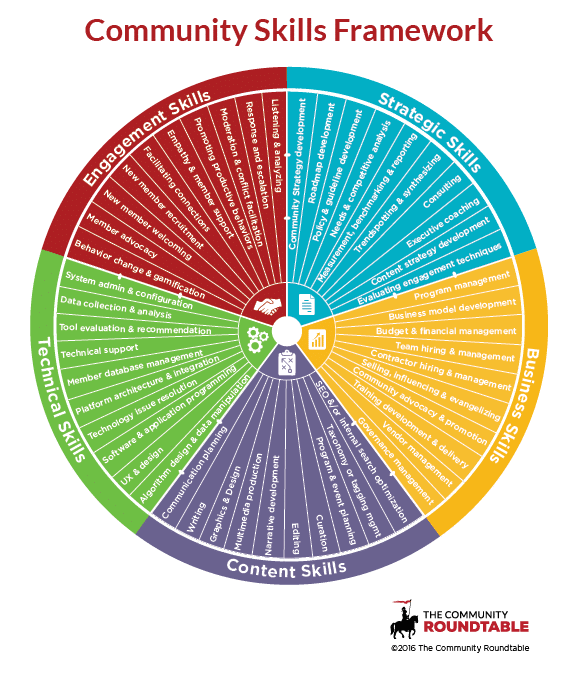The Metrics & Measurement competency of The Community Maturity Model™ helps organizations understand the “why” of social approaches and the results they see when they do. Community teams are often responsible for collecting, analyzing, and reporting back to the organization, which evolves as the community grows. The same occurs as a community program matures: Beginning with activity metrics and anecdotal evidence of behavior change to more performance and behavior-based metrics.
When The Community Roundtable launched in 2009, community managers were responsible for almost everything associated with their community program. As time passed the role changed leading to the creation of the Community Skills Framework™, which highlights five skill families, each with ten skills.

Keeping the Community Skills Framework™ in mind, seeing community metric ownership move from the community manager to a specialist — on the team or elsewhere in the organization — is exciting. On larger teams (or in more mature communities), this work is done by a part-time or dedicated person on the core team (27% in 2022 vs 19% in 2021). Smaller teams often fill this role by someone outside the core team with these specific skills (10% in 2022 vs 7% in 2021).
Gone are the days when communities shared little beyond the core team and executive sponsor.
As more outsiders help the community team report successes via community metrics, the number of “eyeballs” receiving community program reports increases. This trend supports earlier findings that community programs are on their way to becoming a key operational unit. 2022’s respondents reported increased external stakeholder interest in community metrics from senior executives and HR leaders. Boards of directors’ interest stayed consistent year over year.
For those respondents who provided no reporting, if it’s too early to start sharing activity or behavior metrics due to your community’s age, capture examples of new and/or valuable behavior with screenshots. Have an older community? Identify metrics supporting the business use case to start and grow from there. Sharing the community’s impacts on business leads to gained influence and the resources needed to grow your program.
Proving the Value of Community Metrics: Making Strides
As communities mature, organizations want to see the value for the business (at a minimum), and the return on investment (ROI). The last two years’ responses in these areas are promising. There’s been a modest increase in communities proving their value, with even more headed that way. Every community — even young ones — needs to document successes with proving ROI in mind.
ROI is crucial for community managers, as it’s a language business leaders understand. The Community ROI Calculator provides an easy- to-explain framework to show ROI based on a valuable community behavior: Asking and answering questions. With this approach, key constituents in the organization discuss and agree on the value of a community answer, and then it’s simple math from there.
This year’s respondents were less likely to be able to calculate ROI than those in 2021, but they’re actively working on the calculation. Based on collected anecdotal evidence, there’s no reason to believe value in calculating community ROI is decreasing. Instead, those who are in the “no” and “don’t know” categories should try the Community ROI Calculator.

